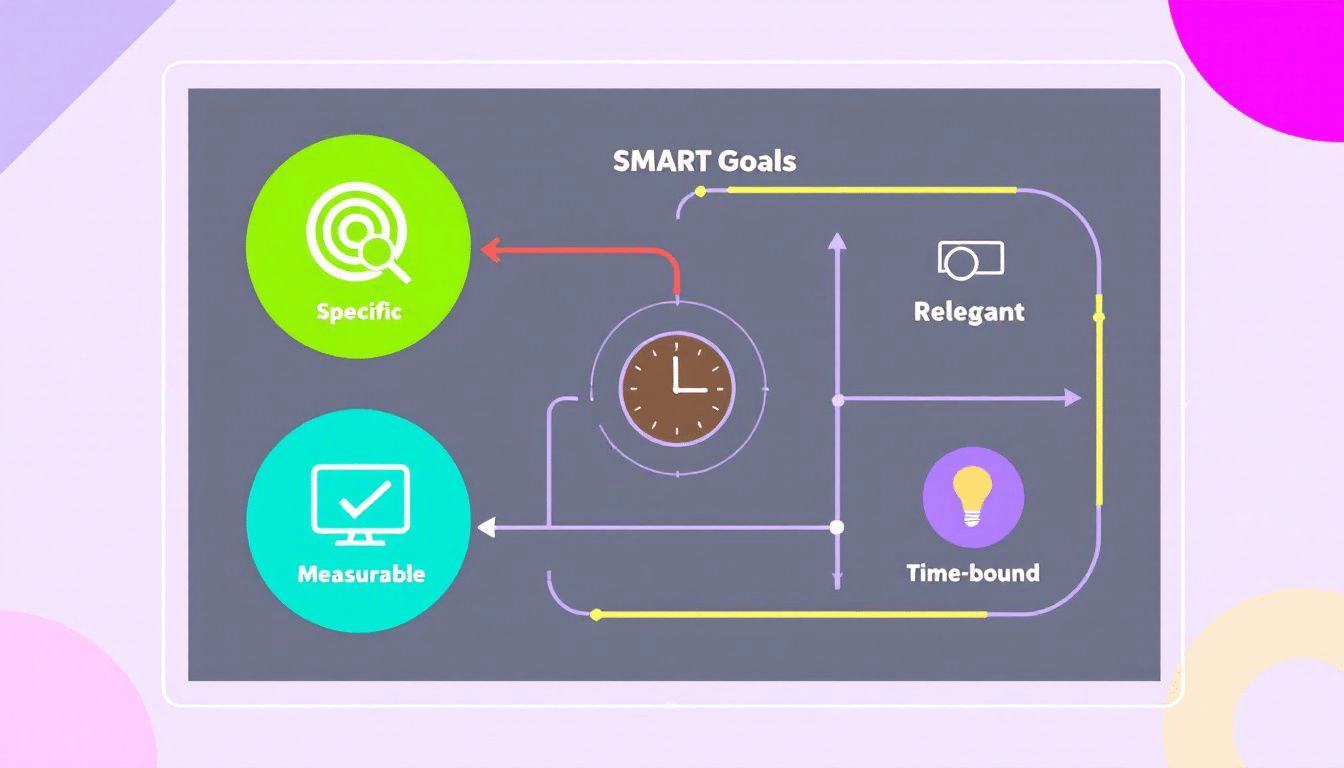What are the components of SMART goals? SMART goals are defined by five key elements: Specific, Measurable, Achievable, Relevant, and Time-bound. These components ensure your objectives are clear and actionable, making it easier to achieve them. This article breaks down each component to guide you in setting effective goals.
Key Takeaways
SMART goals provide a structured framework to transform vague objectives into clear, actionable plans, enhancing focus and accountability.
Each element of SMART—Specific, Measurable, Achievable, Relevant, and Time-bound—plays a crucial role in effective goal setting and tracking progress.
Regularly reviewing and adjusting your goals is essential for maintaining relevance and motivation, ensuring you stay on track for success.
Understanding SMART Goals

SMART goals are the cornerstone of effective planning, providing a structured framework to ensure that your objectives are clear and attainable. The purpose of SMART goals is to transform fuzzy objectives into well-defined goals that support achievement and align with broader aspirations. Smarter goals, structured with defined elements, enhance success rates and maintain motivation.
The SMART framework sets clear, attainable goals with defined timelines, clarifying ideas and focusing efforts. This approach uses time and resources effectively, making it easier to stay on track and achieve desired outcomes. Each element of SMART goals corresponds to crucial questions that aid in defining the goals, providing a roadmap to success.
Breaking Down the SMART Criteria
The acronym SMART stands for Specific, Measurable, Achievable, Relevant, and Time-bound. These criteria help in setting effective goals. These five attributes are essential for refining goals and transforming vague intentions into clear, actionable plans. Breaking down each component allows for the creation of comprehensive, realistic, and attainable goals.
Let’s explore each element in detail to understand how they contribute to effective goal setting.
Specific
A specific goal is the foundation of effective goal setting. It provides clarity by defining exactly what you want to achieve, focusing your efforts, and preventing vagueness. A specific goal answers critical questions such as what needs to be accomplished, who is involved, where it will happen, and any constraints that may apply. For example, aiming to become the head of marketing is a specific goal that clearly defines the desired outcome.
Specificity guides progress and maintains focus, ensuring that every step taken is purposeful and aligned with the end goal. An example of a specific goal might be “Increase sales revenue by $20,000 by the end of the year.” This level of detail helps to eliminate ambiguity and provides a clear target to strive towards.
Measurable
Measurable goals are crucial because they allow you to track progress and evaluate success. In the SMART criteria, the ‘M’ stands for Measurable, signifying the ability to quantify goal achievement. A measurable goal answers questions such as how much, how many, and how to recognize accomplishment. For instance, a goal to “increase website traffic by 25% over the next quarter” includes quantifiable benchmarks to track progress.
Establishing criteria for measuring progress ensures that you can evaluate whether you’re on track to achieve your goals. Words like increase, decrease, and maintain indicate that a goal is measurable. By determining specific milestones and timelines, you can keep track of your progress and make necessary adjustments to stay aligned with your objectives.
Achievable
Achievable goals strike a balance between being challenging and realistic. They are designed to stretch your abilities while remaining within reach to avoid the demotivation that comes with unattainable goals. Consider factors such as existing experience, qualifications, time for training, and available resources when determining if a goal is achievable. For example, setting a growth target of a 25% sales increase when the usual growth is 20% exemplifies an achievable goal.
Realistic and attainable goals take into account the project’s capabilities and resources. An example of an achievable personal goal might be setting aside 20 minutes a day to practice Spanish. This approach ensures that the goal is within your reach, encouraging consistent effort and progress.
Relevant
Relevant goals are critical because they ensure that your targets contribute to broader aspirations, whether personal or organizational. The ‘R’ in SMART goals stands for Relevant, indicating that a relevant goal must matter in the context of larger plans and aspirations.
Aligning goals with personal values or organizational objectives increases motivation and commitment, making it more likely that you’ll stay invested in achieving them.
Time-bound
Time-bound goals are linked to deadlines, creating a sense of urgency that encourages timely progress. Setting deadlines helps maintain focus and motivation, preventing procrastination and ensuring that larger goals are gradually achieved. A well-defined time-bound goal answers questions like “when” and “by when”.
For example, a time-bound goal might be “Complete the new marketing strategy by the end of the next quarter.” This specific timeframe helps to enforce a deadline, making the goal feel more attainable and forcing action.
By establishing a realistic time frame for smaller goals, you can ensure the successful achievement of the final objective.
Examples of SMART Goals

Examples of SMART goals in various contexts can illustrate the practical application of the SMART framework. By examining business, professional, and personal goals, you can see how the SMART criteria are applied to create clear, actionable plans that lead to success.
Let’s explore specific examples in each of these areas.
Business Goal Example
A business goal example might be to boost revenue by 15% in the upcoming quarter through targeted marketing strategies. This goal is specific, measurable, achievable, relevant, and time-bound, making it a perfect illustration of the SMART framework. The goal aligns with broader business objectives and includes clear steps such as implementing a comprehensive digital marketing strategy to enhance customer engagement and drive sales.
Setting measurable business goals is essential for tracking progress and ensuring that objectives are met. By breaking down this goal into smaller tasks, such as launching new marketing campaigns, analyzing customer data, and adjusting strategies based on performance, the business can steadily work towards achieving the desired revenue increase.
Professional Goal Example
A professional goal example could be completing a certified online course in Digital Marketing from EDX by December 31st, 2024. This goal is specific, measurable, achievable, relevant, and time-bound, demonstrating the practical application of the SMART criteria and a smart goal statement. It provides a clear target, a measurable outcome, and a defined timeline, making it easier to stay focused and motivated.
Setting such professional objectives is crucial for career development, as it allows individuals to gain new skills and qualifications that align with their career aspirations. Setting a clear target date and breaking the goal into smaller milestones, like completing modules and passing assessments, helps individuals track progress and stay on course to achieve their professional goals.
Personal Goal Example
A personal goal example might be to lose 10 pounds in 3 months through regular exercise and a balanced diet. This goal is specific, measurable, achievable, relevant, and time-bound, making it a perfect illustration of the SMART framework. It specifies the amount of weight to lose, allows for tracking progress, and includes a realistic plan for achieving the goal.
This personal goal aligns with broader health objectives and provides a clear deadline, ensuring that efforts are consistent and focused. Setting specific targets, such as exercising for 30 minutes a day and following a balanced diet, allows for steady progress towards achieving weight loss goals.
Tips for Creating SMART Goals

Creating effective SMART goals requires careful planning and consideration. Practical tips such as write smart goals, breaking down large goals into manageable tasks, and regularly reviewing and adjusting your goals can enhance their effectiveness through smart goal setting. Using a smart goals template can also streamline this process.
These strategies ensure that your goals remain clear, achievable, and aligned with your broader objectives.
Write Down Your Goals
Documenting your goals is crucial for enhancing commitment and accountability. Writing down goals helps to solidify your intentions and serves as a constant reminder to stay focused on achieving them. This practice enhances commitment and ensures that you remain accountable for your progress and outcomes.
Having written goals ultimately leads to better focus and a higher likelihood of achieving desired outcomes. Documenting your goals creates a roadmap that guides actions and keeps you on track towards achieving your aspirations.
Break Down Large Goals
Breaking down larger goals into smaller, manageable tasks makes it easier to understand the path towards completion. This approach reduces feelings of overwhelm and facilitates steady progress. For example, if your goal is to write a book, breaking it down into smaller tasks such as outlining chapters, writing a certain number of words each day, and setting deadlines for each section can make the goal less daunting.
Making larger goals less daunting encourages consistent effort and achievement over time. Focusing on small, achievable tasks helps maintain momentum and steadily progress towards completing larger goals.
Regularly Review and Adjust
Regularly reviewing and adjusting your goals is essential to ensure they remain relevant and aligned with your evolving priorities. Consistent evaluation allows you to adapt to new circumstances or priorities, keeping your goals achievable and aligned with your broader objectives.
Adjusting goals regularly helps keep them relevant to current circumstances and priorities. Continuously reflecting on progress and making necessary adjustments ensures that goals remain effective and attainable.
Benefits of Using SMART Goals

SMART goals provide numerous benefits, including increased clarity, focus, and motivation. By eliminating ambiguity, SMART goals help you concentrate on essential tasks and prioritize your efforts. This clarity enhances focus and ensures that you direct your resources towards valuable results.
Sharing SMART goals with stakeholders keeps team members accountable and aligned, further boosting motivation. Overall, utilizing SMART goals leads to significant improvements in clarity, motivation, and resource management, making them essential for personal and professional success.
Common Pitfalls and How to Avoid Them
Even with the best intentions, setting SMART goals can sometimes lead to common pitfalls if not approached carefully. One major mistake is failing to set realistic expectations, which can lead to discouragement and a loss of motivation if the goals are too ambitious. Unrealistic goals lead to frustration, demotivation, and eventual abandonment. To avoid this, ensure goals are challenging yet attainable, considering available resources and capabilities.
Neglecting to learn from setbacks hinders personal growth and goal achievement. Additionally, setting goals based on others’ expectations rather than your own can lead to a lack of satisfaction and fulfillment.
Negatively framed goals can demotivate; rephrasing them positively enhances engagement and motivation. Focusing on too many goals at once dilutes efforts; prioritize a few key objectives to maintain focus and effectiveness.
Tracking and Evaluating Progress

Tracking progress is crucial for maintaining momentum in achieving your SMART goals. Regularly checking in on your goals ensures that you are on track and facilitates measuring progress. Utilizing work management tools, spreadsheets, or simple tracking systems can help organize and visualize goal-related data. Selecting appropriate metrics is essential for effectively tracking SMART goals, as it allows you to monitor key performance indicators and task assignments.
Sending regular project status updates to stakeholders keeps everyone informed and enhances the monitoring process through shared data and feedback. Creating weekly project updates that highlight milestones and necessary changes can significantly enhance progress tracking for SMART goals.
Streamlined processes that offer clear reporting can effectively convey updates on goal progress, ensuring that you stay aligned with your objectives.
Summary
In conclusion, SMART goals provide a clear and structured approach to goal setting, transforming vague intentions into actionable plans. By focusing on Specific, Measurable, Achievable, Relevant, and Time-bound criteria, you can create well-defined goals that enhance clarity, motivation, and resource management. Whether you’re setting business, professional, or personal goals, the SMART framework ensures that your objectives are clear, attainable, and aligned with your broader aspirations. Embrace the power of SMART goals and watch your dreams turn into reality.
FAQ
What does the SMART acronym stand for?
The SMART acronym stands for Specific, Measurable, Achievable, Relevant, and Time-bound, guiding you to turn your goals into clear, actionable plans. Embrace this framework to achieve your aspirations effectively!
How can I ensure my goals are achievable?
To ensure your goals are achievable, evaluate your experience, resources, and time commitment. Set realistic targets that challenge you while remaining within reach.
Why is it important to write down my goals?
Writing down your goals is crucial because it boosts your commitment and accountability, leading to improved focus and a greater chance of success. Take action now and see how documenting your goals transforms your journey!
What are some common pitfalls in SMART goal setting?
To avoid common pitfalls in SMART goal setting, focus on realistic expectations and prioritize a few key objectives. Remember to frame your goals positively and learn from any setbacks to stay motivated and succeed!
How can I track and evaluate progress towards my SMART goals?
To effectively track and evaluate progress towards your SMART goals, regularly check in on your objectives, utilize work management tools or spreadsheets to organize your data, and select key performance indicators to monitor. Stay consistent with reporting to ensure you’re on the right path to success!





